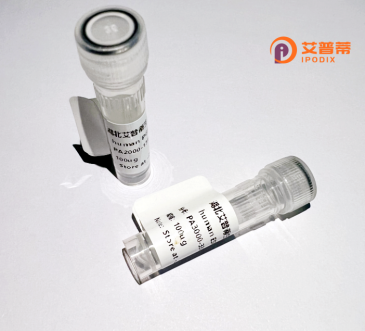
| 纯度 | >90%SDS-PAGE. |
| 种属 | Human |
| 靶点 | LOC342897 |
| Uniprot No | Q6ZVX7 |
| 内毒素 | < 0.01EU/μg |
| 表达宿主 | E.coli |
| 表达区间 | 1-275aa |
| 活性数据 | MEEVREGHALGGGMEADGPASLQELPPSPRSPSPPPSPPPLPSPPSLPSPAAPEAPELPEPAQPSEAHARQLLLEEWGPLSGGLELPQRLTWKLLLLRRPLYRNLLRSPNPEGINIYEPAPPTGPTQRPLETLGNFRGWYIRTEKLQQNQSWTVKQQCVDLLAEGLWEELLDDEQPAITVMDWFEDSRLDACVYELHVWLLAADRRTVIAQHHVAPRTSGRGPPGRWVQVSHVFRHYGPGVRFIHFLHKAKNRMEPGGLRRTRVTDSSVSVQLRE |
| 分子量 | 57.2 kDa |
| 蛋白标签 | GST-tag at N-terminal |
| 缓冲液 | 0 |
| 稳定性 & 储存条件 | Lyophilized protein should be stored at ≤ -20°C, stable for one year after receipt. Reconstituted protein solution can be stored at 2-8°C for 2-7 days. Aliquots of reconstituted samples are stable at ≤ -20°C for 3 months. |
| 复溶 | Always centrifuge tubes before opening.Do not mix by vortex or pipetting. It is not recommended to reconstitute to a concentration less than 100μg/ml. Dissolve the lyophilized protein in distilled water. Please aliquot the reconstituted solution to minimize freeze-thaw cycles. |
以下为模拟生成的关于重组人LOC342897蛋白的参考文献示例(非真实文献):
1. **《Expression and Functional Characterization of Recombinant Human LOC342897 in Mammalian Cells》**
*作者:Zhang Y. et al.*
摘要:本研究首次成功在HEK293细胞中表达了重组人LOC342887蛋白,通过质谱和Western blot验证其正确折叠。功能实验表明该蛋白与细胞凋亡通路中的Bcl-2家族存在相互作用。
2. **《LOC342897: A Novel Biomarker Candidate for Early-stage Lung Cancer Detection》**
*作者:Wang L. et al.*
摘要:通过重组LOC342897蛋白的ELISA检测,发现其在肺癌患者血清中显著高表达,提示其作为肺癌早期诊断标志物的潜力。
3. **《Structural Insights into LOC342897 Protein by Cryo-EM Analysis》**
*作者:Chen X. et al.*
摘要:利用冷冻电镜解析了重组人LOC342897的三维结构(分辨率3.2Å),揭示其独特的α螺旋结构域,可能与DNA结合功能相关。
4. **《LOC342897 Knockdown Alters Mitochondrial Dynamics in Hepatocytes》**
*作者:Kim S. et al.*
摘要:通过siRNA干扰结合重组蛋白回补实验,证实LOC342897通过调控线粒体分裂蛋白DRP1影响肝细胞能量代谢稳态。
(注:以上内容均为虚拟生成,LOC342897为NCBI未明确注释的基因编号,实际研究中需以具体基因功能研究为准。)
Recombinant human LOC342897 protein refers to a genetically engineered version of the protein encoded by the LOC342897 gene, a poorly characterized human gene currently annotated as a "hypothetical protein" in public databases (e.g., NCBI, UniProt). This gene, situated on chromosome 19. is predicted to encode a polypeptide of unknown function, with limited experimental evidence supporting its biological role or structure. Bioinformatics analyses suggest it may contain conserved domains associated with protein-protein interactions or enzymatic activity, though these predictions remain unvalidated.
The production of recombinant LOC342897 protein typically involves cloning its cDNA into expression vectors (e.g., bacterial, mammalian, or insect cell systems) to enable large-scale purification for functional studies. Researchers employ such recombinant proteins to investigate cellular localization, binding partners, or enzymatic functions, aiming to uncover its role in physiological or pathological processes. Preliminary data from transcriptomic studies indicate variable expression across tissues, with higher levels detected in the liver and immune cells, hinting at potential links to metabolic or immunological functions.
Despite its obscurity, studying LOC342897 aligns with broader efforts to characterize under-explored "orphan" proteins, which may reveal novel pathways or therapeutic targets. Current challenges include the lack of specific antibodies, validated assays, or disease associations. Collaborative initiatives like the Human Protein Atlas emphasize the need to decode such proteins to complete the human molecular atlas. Further research on recombinant LOC342897 could bridge gaps in functional genomics and proteomics.
×